Laparoscopic Surgery: A Systematic Review of Loop and Knot Security, Varying with the Suture and Sequences, Throws, Rotation and Destabilization of Half-Knots or Half-Hitches
Abstract
1. Introduction
2. Materials and Methods
3. Definitions and the Basics of Knot Tying
3.1. Knots Are Sequences of Half-Knots and Half-Hitches
3.2. Nomenclature of Knots and Historical Perspective
3.3. Testing and Definitions of Loop and Knot Security
4. Understanding Knot and Loop Security
4.1. Loop Security
4.2. Knot Security
5. Which Knots to Use in Laparoscopic Surgery
5.1. Considering Loop Security
5.2. Considering Knot Security
5.3. Knots and Postoperative Adhesion Formation
6. Discussion
7. Conclusions
Funding
Institutional Review Board Statement
Informed Consent Statement
Data Availability Statement
Conflicts of Interest
References
- Trimbos, J.B.; Klopper, P.J. Knot security of synthetic absorbable suture material; a comparison of polyglycolic acid and polyglactin-910. Eur. J. Obstet. Gynecol. Reprod. Biol. 1985, 19, 183–190. [Google Scholar] [CrossRef] [PubMed]
- Wong, Y.R.; McGrouther, D.A. Biomechanics of surgical knot security: A systematic review. Int. J. Surg. 2023, 109, 481–490. [Google Scholar] [CrossRef] [PubMed]
- Taysi, A.E.; Taysi, N.M.; Sismanoglu, S. Does Knot Configuration Improve Tensile Characteristics of Monofilament Suture Materials? J. Oral. Maxillofac. Surg. 2023, 81, 72–79. [Google Scholar] [CrossRef] [PubMed]
- Wang, M.; Xiang, X.; Wang, Y.; Ren, Y.; Yang, L.; Zhang, Y. Comparison of Tensile Properties and Knot Security of Surgical Sutures: An In Vitro Mechanical Study. J. Oral. Maxillofac. Surg. 2022, 80, 1215–1222. [Google Scholar] [CrossRef]
- Krnic Martinic, M.; Pieper, D.; Glatt, A.; Puljak, L. Definition of a systematic review used in overviews of systematic reviews, meta-epidemiological studies and textbooks. BMC Med. Res. Methodol. 2019, 19, 203. [Google Scholar] [CrossRef]
- Gillen, A.M.; Munsterman, A.S.; Hanson, R.R. In Vitro Evaluation of the Size, Knot Holding Capacity, and Knot Security of the Forwarder Knot Compared to Square and Surgeon’s Knots Using Large Gauge Suture. Vet. Surg. 2016, 45, 1034–1040. [Google Scholar] [CrossRef]
- Chisnall, R.C. Analysing knots and ligatures: Tying principles, knot characteristics and structural changes. Forensic Sci. Int. 2020, 313, 110272. [Google Scholar] [CrossRef]
- Romeo, A.; Rocha, C.L.; Fernandes, L.F.; Asencio, F.A.; Zomer, M.T.; Fujimoto, C.; Ussia, A.; Wattiez, A.; Koninckx, P.R.; Kondo, W. What is the Best Surgeon’s Knot? Evaluation of the Security of the Different Laparoscopic Knot Combinations. J. Minim. Invasive Gynecol. 2018, 25, 902–911. [Google Scholar] [CrossRef]
- Romeo, A.; Fernandes, L.F.; Cervantes, G.V.; Botchorishvili, R.; Benedetto, C.; Adamyan, L.; Ussia, A.; Wattiez, A.; Kondo, W.; Koninckx, P.R. Which Knots Are Recommended in Laparoscopic Surgery and How to Avoid Insecure Knots. J. Minim. Invasive Gynecol. 2020, 27, 1395–1404. [Google Scholar] [CrossRef]
- Schubert, D.C.; Unger, J.B.; Mukherjee, D.; Perrone, J.F. Mechanical performance of knots using braided and monofilament absorbable sutures. Am. J. Obstet. Gynecol. 2002, 187, 1438–1440; discussion 1441–1442. [Google Scholar] [CrossRef]
- Van Leeuwen, N.; Trimbos, J.B. Strength of sliding knots in multifilament resorbable suture materials. Gynecol. Surg. 2012, 9, 433–437. [Google Scholar] [CrossRef][Green Version]
- Trimbos, J.B. Security of various knots commonly used in surgical practice. Obstet. Gynecol. 1984, 64, 274–280. [Google Scholar]
- Ishikawa, N.; Watanabe, G. Figure 4 Knot: Simple Tying Technique for Robotic and Endoscopic Sutures. Innovations 2017, 12, 152–153. [Google Scholar] [CrossRef] [PubMed]
- Romeo, A.; Cipullo, I.; Kondo, W.; Benedetto, C.; Amro, B.; Ussia, A.; Wattiez, A.; Koninckx, P.R. The importance of rotation to teach secure half-hitch sequences in surgery. FVVOG, 2023; in press. [Google Scholar]
- Mackenzie, M.W. Laparoscopic intracorporeal cinch knots: Changing the square knot paradigm. J. Minim. Invasive Gynecol. 2012, 19, 225–235. [Google Scholar] [CrossRef]
- Ivy, J.J.; Unger, J.B.; Hurt, J.; Mukherjee, D. The effect of number of throws on knot security with nonidentical sliding knots. Am. J. Obstet. Gynecol. 2004, 191, 1618–1620. [Google Scholar] [CrossRef]
- Tera, H.; Aberg, C. Strength of knots in surgery in relation to type of knot, type of suture material and dimension of suture thread. Acta Chir. Scand. 1977, 143, 75–83. [Google Scholar] [PubMed]
- Amortegui, J.D.; Restrepo, H. Knot security in laparoscopic surgery. Surg. Endosc. 2002, 16, 1598–1602. [Google Scholar] [CrossRef]
- Kondo, W.; Zomer, M.T.; Hayashi, R.M.; Fernandes, L.F.; Fujimoto, C.; Romeo, A. Different Blocking Sequences Performed by Laparoscopy. J. Minim. Invasive Gynecol. 2018, 25, 773. [Google Scholar] [CrossRef]
- Tremolada, G.; Hazenfield, K.M.; Smeak, D.D. In vitro holding security of four friction knots of monofilament or multifilament suture used as a first throw for vascular ligation. Am. J. Vet. Res. 2020, 81, 821–826. [Google Scholar] [CrossRef] [PubMed]
- Scott, J.F.; Ascha, M.; Pollard, W.; Bordeaux, J.S. A granny sliding knot for high-tension closures. J. Am. Acad. Dermatol. 2019, 80, e145–e146. [Google Scholar] [CrossRef] [PubMed]
- Burrow, R.; Batchelor, D.; Cripps, P. Complications observed during and after ovariohysterectomy of 142 bitches at a veterinary teaching hospital. Vet. Rec. 2005, 157, 829–833. [Google Scholar] [CrossRef]
- Sanders, R.E.; Kearney, C.M.; Buckley, C.T.; Jenner, F.; Brama, P.A. Knot Security of 5 Metric (USP 2) Sutures: Influence of Knotting Technique, Suture Material, and Incubation Time for 14 and 28 Days in Phosphate Buffered Saline and Inflamed Equine Peritoneal Fluid. Vet. Surg. 2015, 44, 723–730. [Google Scholar] [CrossRef] [PubMed]
- Akiki, R.K.; Rao, V.; Borrelli, M.R.; Beqiri, D.; Liu, P.Y. To Tie or Not to Knot: How the Half Instrument Tie Technique Outdoes the Traditional Surgeon’s Knot. Plast. Reconstr. Surg. 2022, 149, 162e–164e. [Google Scholar] [CrossRef] [PubMed]
- Mohamed Rizvi, Z.; Hameed, A.; Pleass, H. Recognition of the ‘Reversed 4’ pattern of surgical knot tying. Clin. Teach. 2021, 18, 219–221. [Google Scholar] [CrossRef] [PubMed]
- Wattiez, A.; Schindler, L.; Ussia, A.; Campo, R.; Keckstein, J.; Grimbizis, G.; Exacoustos, C.; Kondo, W.; Nezhat, C.; Canis, M.; et al. A proof of concept that experience-based management of endometriosis complements evidence-based guidelines. FVVOG, 2023; in press. [Google Scholar]
- Ivy, J.J.; Unger, J.B.; Mukherjee, D. Knot integrity with nonidentical and parallel sliding knots. Am. J. Obstet. Gynecol. 2004, 190, 83–86. [Google Scholar] [CrossRef] [PubMed]
- Al-Benna, S.; Banieghbal, B. A technique to secure a knot in a confined space. Ann. R. Coll. Surg. Engl. 2020, 102, 759. [Google Scholar] [CrossRef] [PubMed]
- Romeo, A.; Fujimoto, C.; Cipullo, I.; Giarola, M.; Benedetto, C.; Kondo, W.; Amro, B.; Ussia, A.; Wattiez, A.; Koninckx, P.R. Effect of diameter and type of suture on knot and loop security. J. Clin. Med. 2023; submitted. [Google Scholar]
- Shepherd, G.; Romero, R.; Grant, H. Slip-Knot-Loop Suture for Continuous Suturing in Laparoscopy. J. Laparoendosc. Adv. Surg. Tech. A 2016, 26, 231–234. [Google Scholar] [CrossRef] [PubMed]
- Meylemans, D.; Handojo, K.; Devroe, K.; Aelvoet, C.; Vermeiren, K.; Tollens, T. A Modified Fisherman’s Knot for Laparoscopic Suturing. Surg. Technol. Int. 2016, 28, 37–39. [Google Scholar] [PubMed]
- Erickson, A.K.; Fox-Alvarez, W.A.; Regier, P.J.; Case, J.B. In vitro holding strength of the laparoscopic Miller’s knot compared with open Miller’s knot, open surgeon’s throw, and laparoscopic surgeon’s throw in a vascular pedicle model. Vet. Surg. 2020, 49, 1563–1570. [Google Scholar] [CrossRef] [PubMed]
- Ortillés, A.; Rodríguez, J.; Calvo, B. The Miller’s knot as an alternative to the surgical knotting? Characterization of the mechanical behavior. J. Mech. Behav. Biomed. Mater. 2014, 38, 154–162. [Google Scholar] [CrossRef] [PubMed]
- Taylor, H.; Grogono, A.W. The constrictor knot is the best ligature. Ann. R. Coll. Surg. Engl. 2014, 96, 101–105. [Google Scholar] [CrossRef] [PubMed]
- Silver, E.; Wu, R.; Grady, J.; Song, L. Knot Security-How is it Affected by Suture Technique, Material, Size, and Number of Throws? J. Oral. Maxillofac. Surg. 2016, 74, 1304–1312. [Google Scholar] [CrossRef]
- Coleridge, M.; Gillen, A.M.; Farag, R.; Hanson, R.R.; Munsterman, A.S. Effect of fluid media on the mechanical properties of continuous pattern-ending surgeon’s, square, and Aberdeen knots in vitro. Vet. Surg. 2017, 46, 306–315. [Google Scholar] [CrossRef]
- Marturello, D.M.; McFadden, M.S.; Bennett, R.A.; Ragetly, G.R.; Horn, G. Knot security and tensile strength of suture materials. Vet. Surg. 2014, 43, 73–79. [Google Scholar] [CrossRef] [PubMed]
- Ching, S.S.; Mok, C.W.; Koh, Y.X.; Tan, S.M.; Tan, Y.K. Assessment of surgical trainees’ quality of knot-tying. J. Surg. Educ. 2013, 70, 48–54. [Google Scholar] [CrossRef]
- Armitage, P.; Berry, G. Factorial Designs. Statistical Methods in Medical Research, 2nd ed.; Publications, B.S., Ed.; Blackwell Scientific Publications: Oxford, UK, 1987. [Google Scholar]
- Takayasu, K.; Yoshida, K.; Kinoshita, H.; Yoshimoto, S.; Oshiro, O.; Matsuda, T. Analysis of the tractive force pattern on a knot by force measurement during laparoscopic knot tying. Am. J. Surg. 2018, 216, 314–318. [Google Scholar] [CrossRef]
- Muffly, T.M.; Kow, N.; Iqbal, I.; Barber, M.D. Minimum number of throws needed for knot security. J. Surg. Educ. 2011, 68, 130–133. [Google Scholar] [CrossRef]
- Koninckx, P.R.; Gomel, V.; Ussia, A.; Adamyan, L. Role of the peritoneal cavity in the prevention of postoperative adhesions, pain, and fatigue. Fertil. Steril. 2016, 106, 998–1010. [Google Scholar] [CrossRef]
- Tidwell, J.E.; Kish, V.L.; Samora, J.B.; Prud’homme, J. Knot security: How many throws does it really take? Orthopedics 2012, 35, e532–e537. [Google Scholar] [CrossRef]
- Dahl, K.A.; Patton, D.J.; Dai, Q.; Wongworawat, M.D. Biomechanical characteristics of 9 arthroscopic knots. Arthroscopy 2010, 26, 813–818. [Google Scholar] [CrossRef] [PubMed]
- Wuennenberg, J.; Kolli, S.S.; Powers, M.; Ozog, D. Surgeon’s Knot With 3 Throws to Facilitate Wound Closure: A Video Walkthrough. Dermatol. Surg. 2023, 49, 309. [Google Scholar] [CrossRef] [PubMed]
- Batra, E.K.; Taylor, P.T.; Franz, D.A.; Towler, M.A.; Edlich, R.F. A portable tensiometer for assessing surgeon’s knot tying technique. Gynecol. Oncol. 1993, 48, 114–118. [Google Scholar] [CrossRef] [PubMed]
- Molinas, C.R.; Binda, M.M.; Sisa, C.M.; Campo, R. A randomized control trial to evaluate the importance of pre-training basic laparoscopic psychomotor skills upon the learning curve of laparoscopic intra-corporeal knot tying. Gynecol. Surg. 2017, 14, 29. [Google Scholar] [CrossRef]
- Horeman, T.; Blikkendaal, M.D.; Feng, D.; van Dijke, A.; Jansen, F.; Dankelman, J.; van den Dobbelsteen, J.J. Visual force feedback improves knot-tying security. J. Surg. Educ. 2014, 71, 133–141. [Google Scholar] [CrossRef]
- Huffman, E.; Anton, N.; Martin, J.; Timsina, L.; Dearing, W.; Breece, B.; Mann, I.; Stefanidis, D. Optimizing Assessment of Surgical Knot Tying Skill. J. Surg. Educ. 2020, 77, 1577–1582. [Google Scholar] [CrossRef]
- Romero, P.; Gerhaeuser, A.; Carstensen, L.; Kössler-Ebs, J.; Wennberg, E.; Schmidt, M.W.; Müller-Stich, B.P.; Günther, P.; Nickel, F. Learning of Intracorporal Knot Tying in Minimally Invasive Surgery by Video or Expert Instruction. Eur. J. Pediatr. Surg. 2023, 33, 228–233. [Google Scholar] [CrossRef] [PubMed]
- Elrod, J.; Boettcher, J.; Vincent, D.; Schwarz, D.; Trautmann, T.; Reinshagen, K.; Boettcher, M. Telementoring of Open and Laparoscopic Knot Tying and Suturing Is Possible: A Randomized Controlled Study. Eur. J. Pediatr. Surg. 2022, 32, 443–451. [Google Scholar] [CrossRef]
- Nagaraj, M.B.; Namazi, B.; Sankaranarayanan, G.; Scott, D.J. Developing artificial intelligence models for medical student suturing and knot-tying video-based assessment and coaching. Surg. Endosc. 2023, 37, 402–411. [Google Scholar] [CrossRef]
- De Witte, B.; Di Rienzo, F.; Martin, X.; Haixia, Y.; Collet, C.; Hoyek, N. Implementing Cognitive Training Into a Surgical Skill Course: A Pilot Study on Laparoscopic Suturing and Knot Tying. Surg. Innov. 2018, 25, 625–635. [Google Scholar] [CrossRef]
- Muffly, T.M.; Espaillat-Rijo, L.M.; Edwards, A.M.; Horton, A. Operating room fatigue: Is your twentieth surgical knot as strong as your first? J. Surg. Educ. 2012, 69, 215–217. [Google Scholar] [CrossRef]
- Babetty, Z.; Sumer, A.; Altintas, S. Knot properties of alternating sliding knots with different patterns in comparison to alternating and simple sliding knots. J. Am. Coll. Surg. 1998, 186, 485–489. [Google Scholar] [CrossRef] [PubMed]
- Babetty, Z. Changes in Knot-Holding Capacity of Sliding Knots In Vivo and Tissue Reaction. Arch. Surg. 1998, 133, 727. [Google Scholar] [CrossRef] [PubMed][Green Version]
- Chong, A.C.; Ochs, J.L.; Zackula, R.E.; MacFadden, L.N.; Prohaska, D.J. The Effect of Different Combinations of Three Stacked Half-Hitches and Suture Materials on an Arthroscopic Knot in a Dry or Wet Environment. Iowa Orthop. J. 2018, 38, 79–86. [Google Scholar]
- Meyer, D.C.; Bachmann, E.; Lädermann, A.; Lajtai, G.; Jentzsch, T. The best knot and suture configurations for high-strength suture material. An in vitro biomechanical study. Orthop. Traumatol. Surg. Res. 2018, 104, 1277–1282. [Google Scholar] [CrossRef] [PubMed]
- Corey, C.S.; Wenger, K.; Johnson, C.P.; Parada, M.S. Loop and knot security of a novel arthroscopic sliding-locking knot using high-strength sutures. J. Orthop. 2018, 15, 980–983. [Google Scholar] [CrossRef]
- Kelly, J.D.; Vaishnav, S.; Saunders, B.M.; Schrumpf, M.A. Optimization of the Racking Hitch Knot: How Many Half Hitches and Which Suture Material Provide the Greatest Security? Clin. Orthop. Relat. Res. 2014, 472, 1930–1935. [Google Scholar] [CrossRef] [PubMed][Green Version]
- Zhao, C.; Hsu, C.-C.; Moriya, T.; Thoreson, A.R.; Cha, S.S.; Moran, S.L.; An, K.-N.; Amadio, P.C. Beyond the Square Knot: A Novel Knotting Technique for Surgical Use. J. Bone Jt. Surg. 2013, 95, 1020–1027. [Google Scholar] [CrossRef]
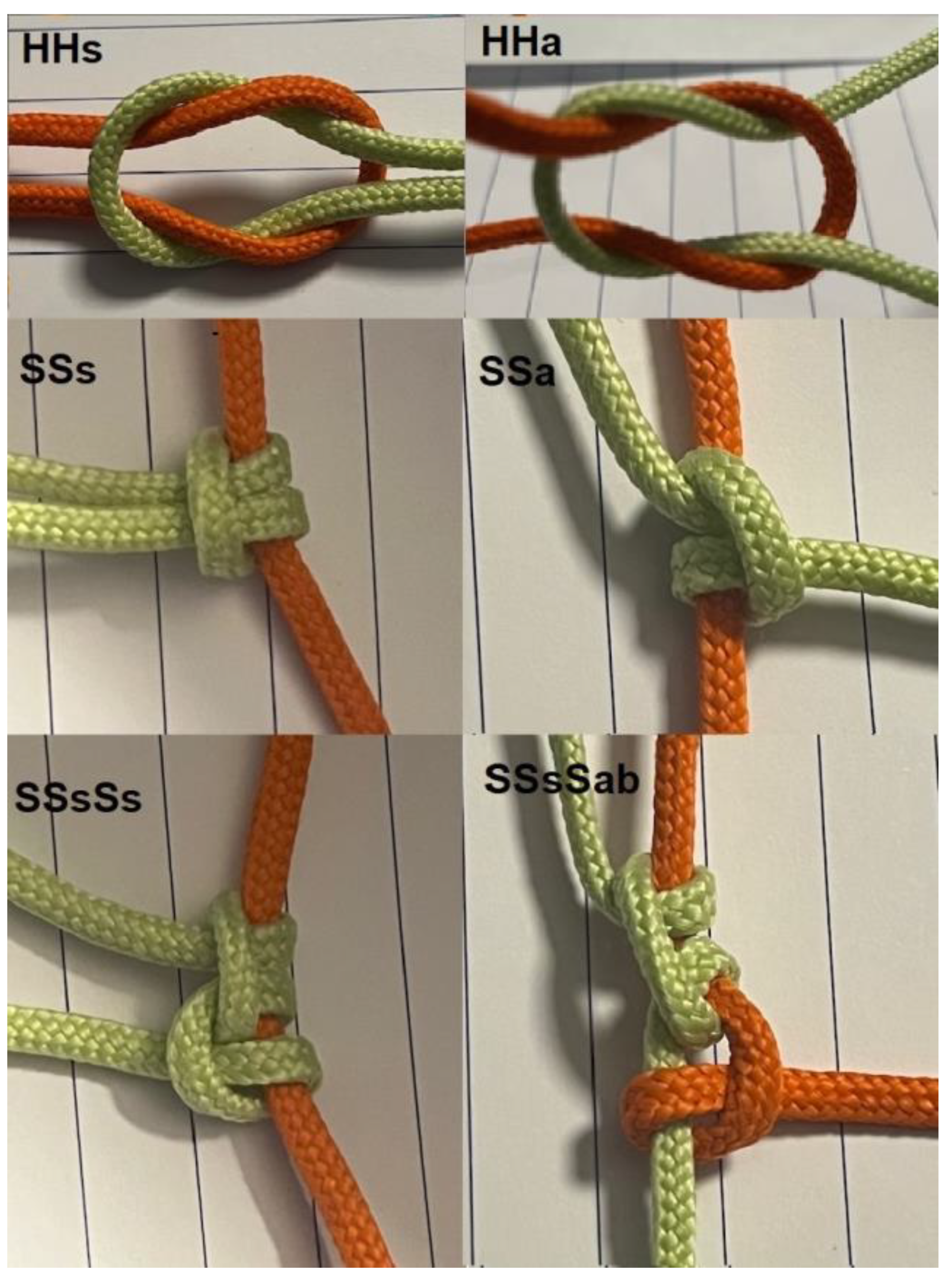
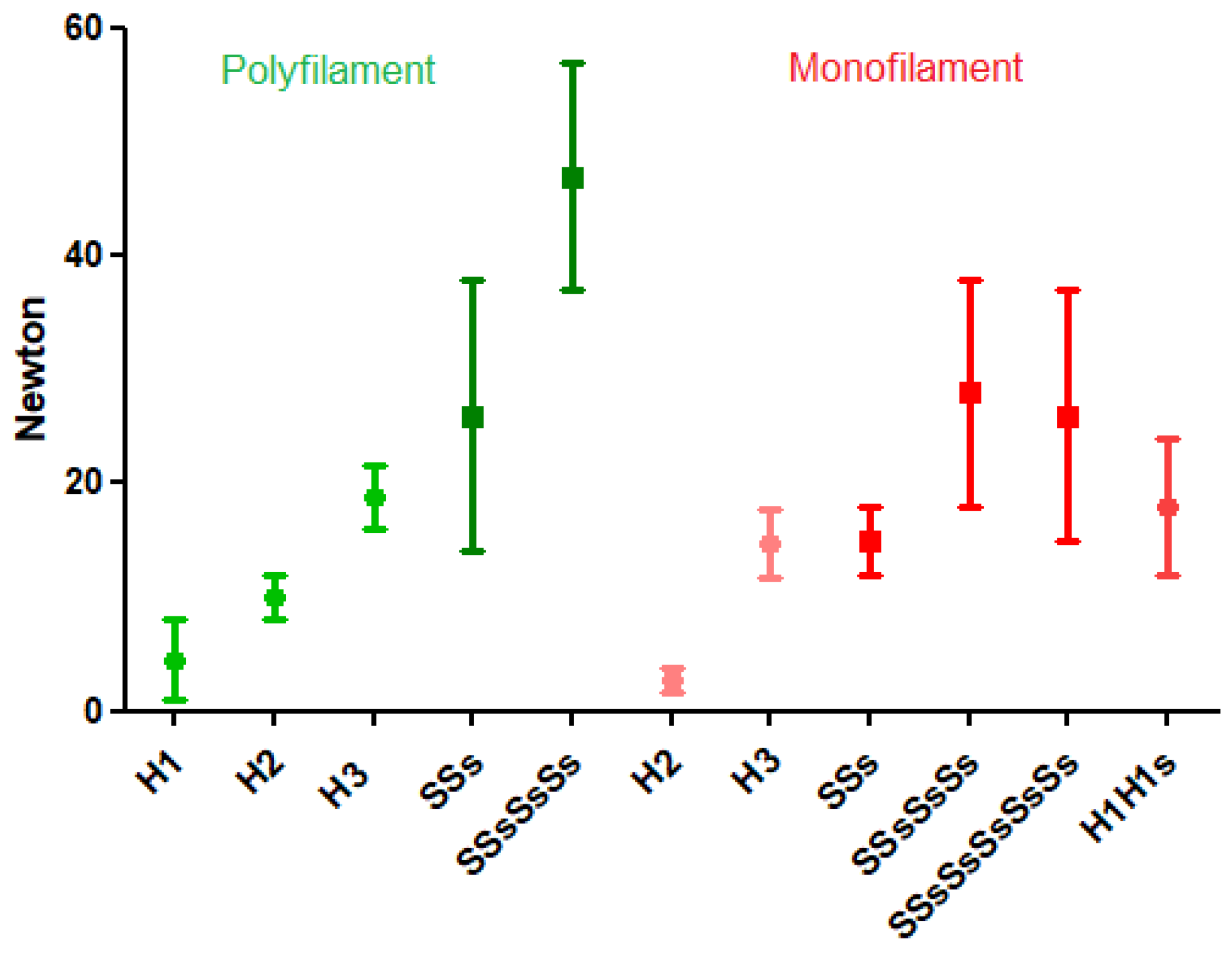
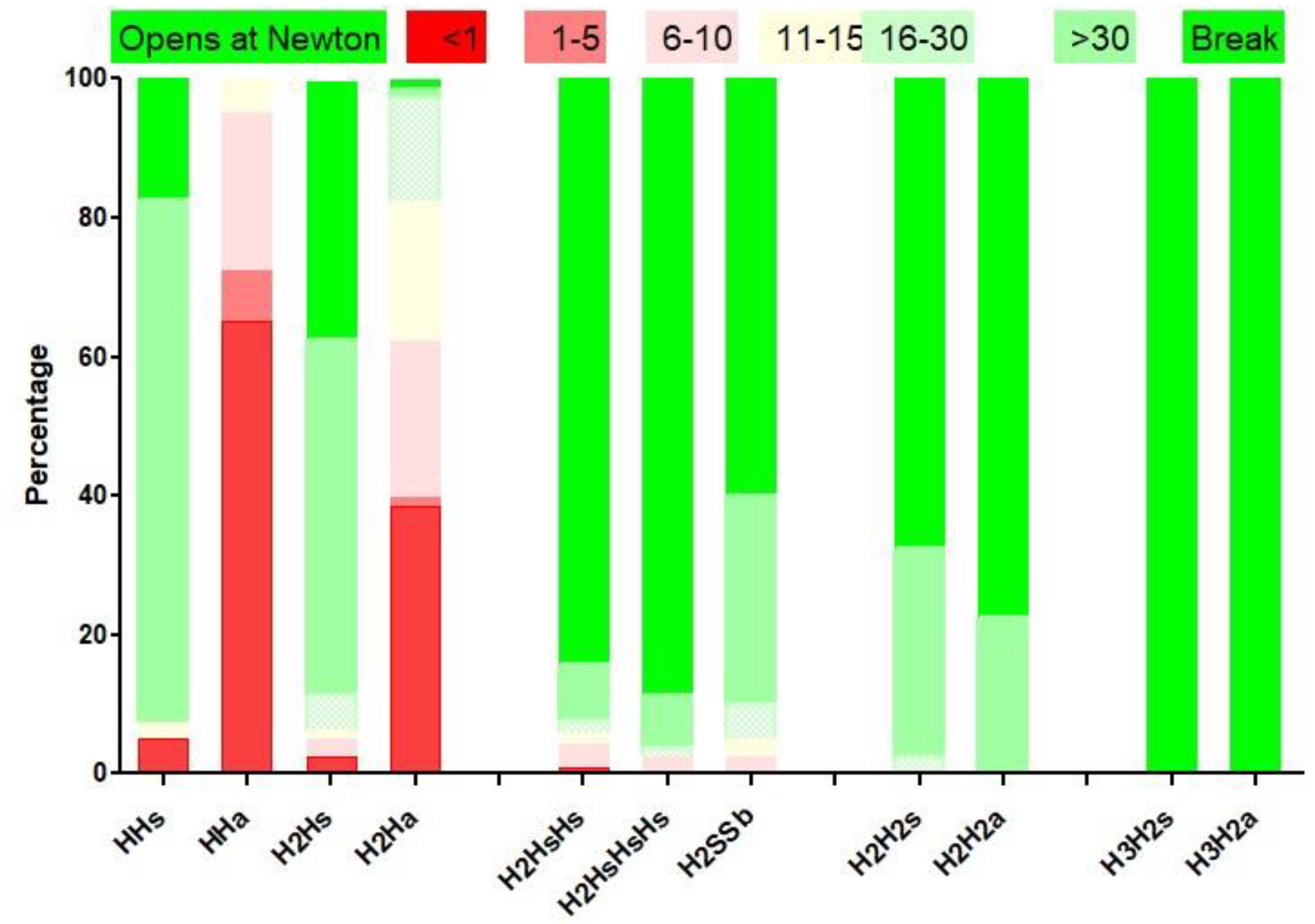
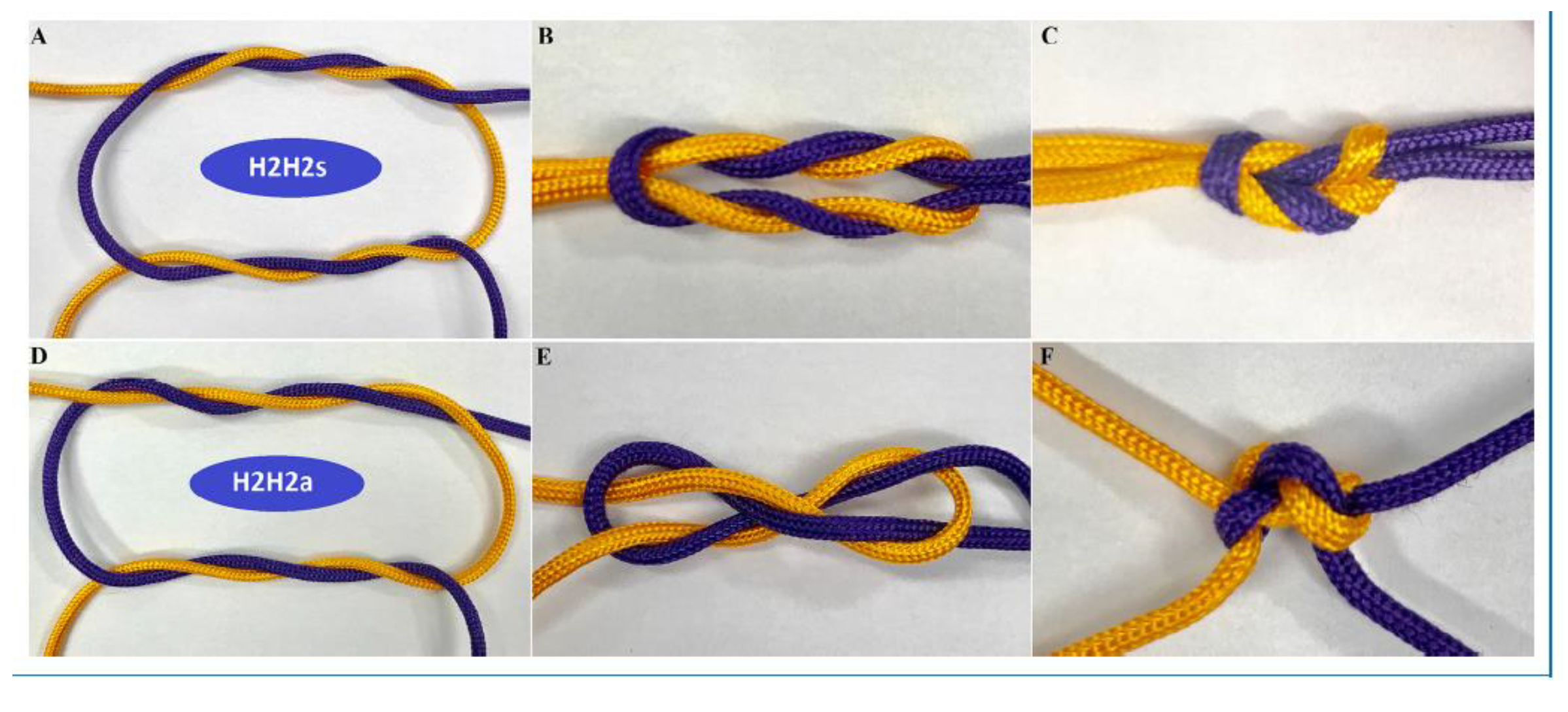
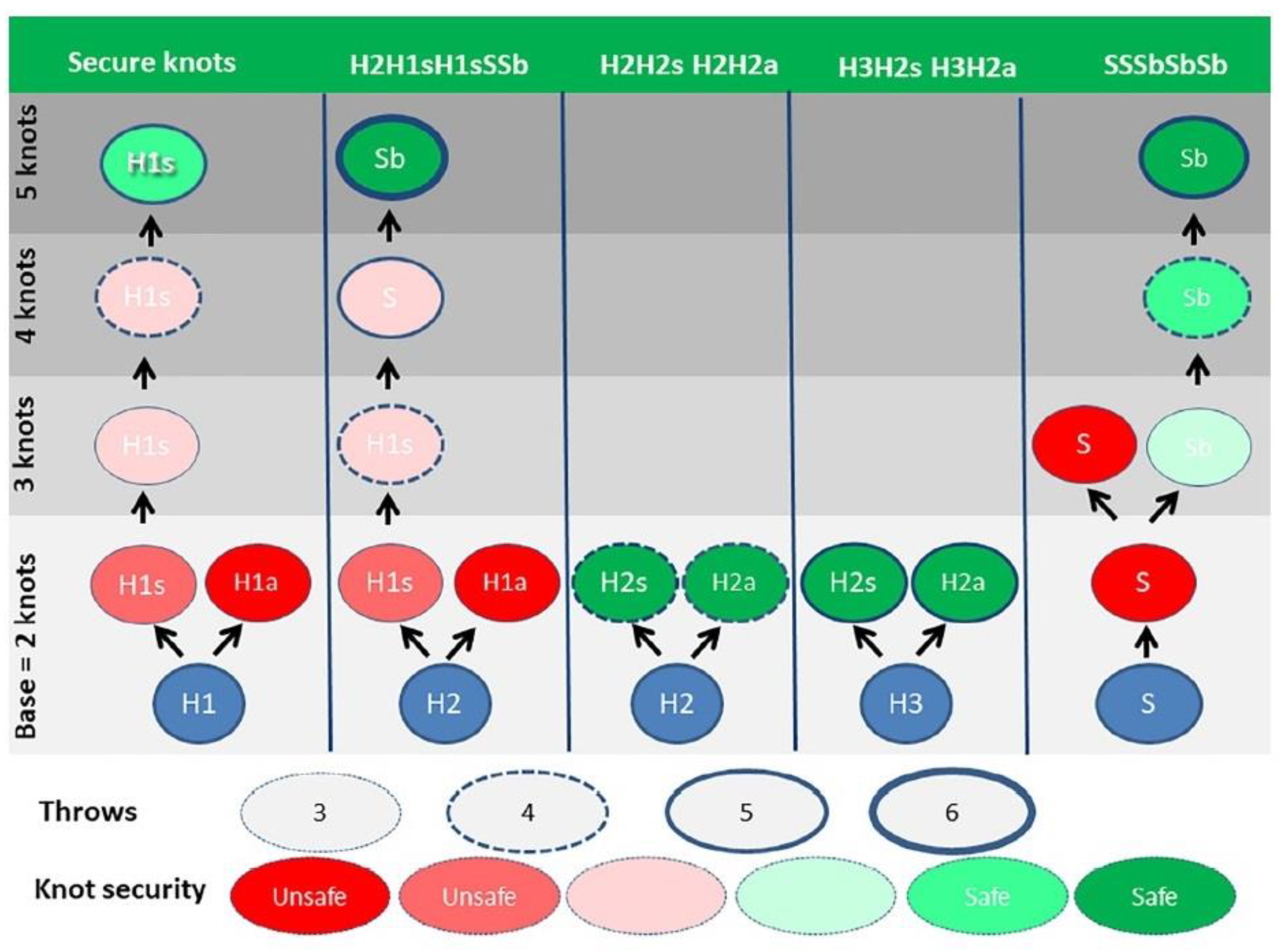
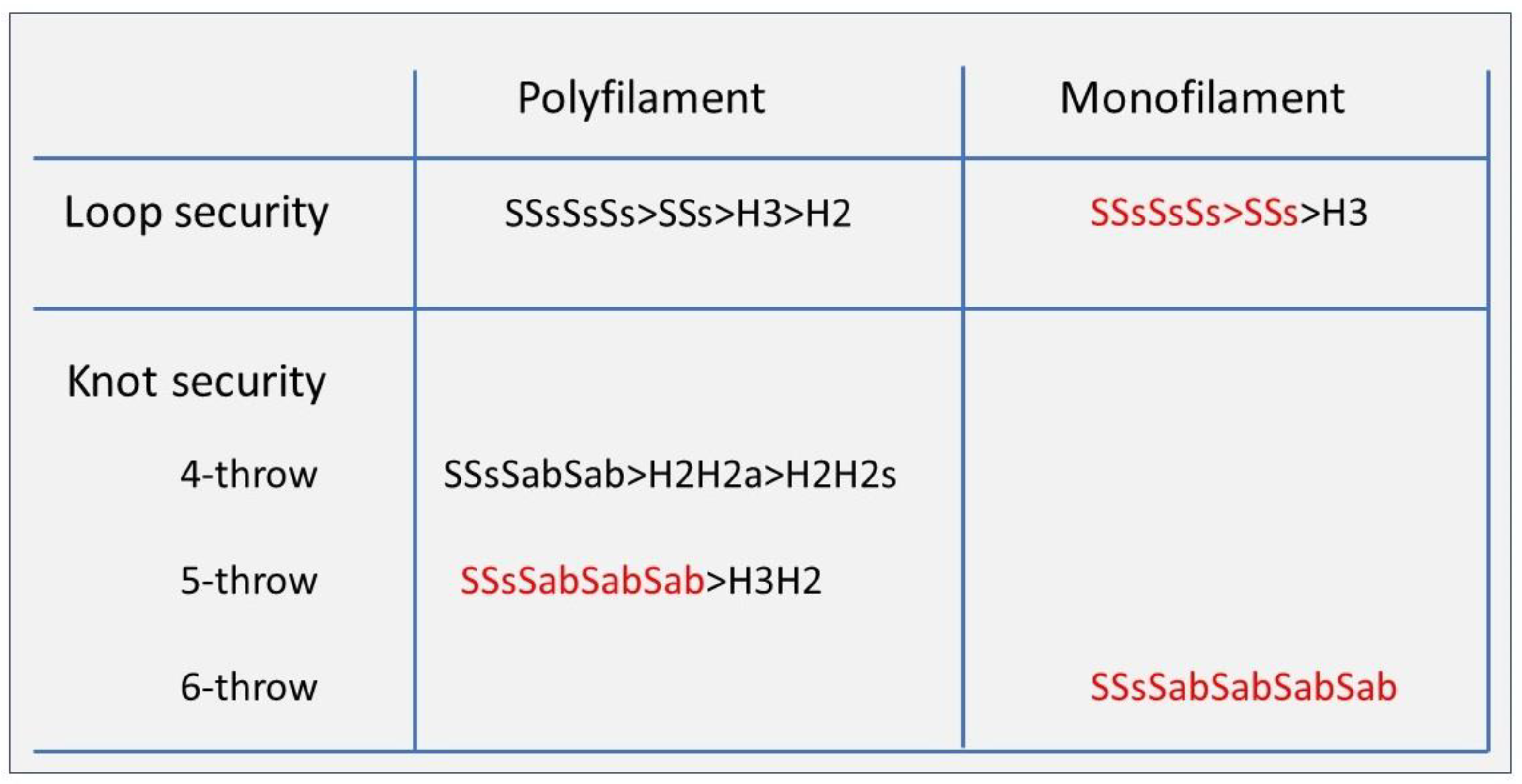
| Knots | Throws | Knot Sequences | Rotation | Older Indication | New Indication |
|---|---|---|---|---|---|
| Half-knot | 1, 2, 3 | H1, H2, H3 | |||
| 2nd symmetric | alternate | H=H, 1=1 | H1H1s, H2H1s, H2H2s, H3H2s | ||
| 2nd asymmetric | similar | HxH, 1x1 | H1H1a, H2H1a, H2H2a, H3H2a | ||
| Secure half-knot sequences: H2H1sH1s, H2H2s or H2H2a, H3H2s or H3H2a | |||||
| Half-hitch | 1, 2 | S(1), (S2) | |||
| 2nd symmetric | alternate | ||||
| sliding | S=S, 1=1 | SSs(s) | |||
| blocking | S//S | SSsb | |||
| 2nd asymmetric | similar | ||||
| sliding | SxS, 1x1 | SSa(s) | |||
| blocking | S//xS | SSab | |||
| Secure half-hitch sequences: SSsSabSab | |||||
Disclaimer/Publisher’s Note: The statements, opinions and data contained in all publications are solely those of the individual author(s) and contributor(s) and not of MDPI and/or the editor(s). MDPI and/or the editor(s) disclaim responsibility for any injury to people or property resulting from any ideas, methods, instructions or products referred to in the content. |
© 2023 by the authors. Licensee MDPI, Basel, Switzerland. This article is an open access article distributed under the terms and conditions of the Creative Commons Attribution (CC BY) license (https://creativecommons.org/licenses/by/4.0/).
Share and Cite
Koninckx, P.R.; Ussia, A.; Wattiez, A.; Kondo, W.; Romeo, A. Laparoscopic Surgery: A Systematic Review of Loop and Knot Security, Varying with the Suture and Sequences, Throws, Rotation and Destabilization of Half-Knots or Half-Hitches. J. Clin. Med. 2023, 12, 6166. https://doi.org/10.3390/jcm12196166
Koninckx PR, Ussia A, Wattiez A, Kondo W, Romeo A. Laparoscopic Surgery: A Systematic Review of Loop and Knot Security, Varying with the Suture and Sequences, Throws, Rotation and Destabilization of Half-Knots or Half-Hitches. Journal of Clinical Medicine. 2023; 12(19):6166. https://doi.org/10.3390/jcm12196166
Chicago/Turabian StyleKoninckx, Philippe R., Anastasia Ussia, Arnaud Wattiez, William Kondo, and Armando Romeo. 2023. "Laparoscopic Surgery: A Systematic Review of Loop and Knot Security, Varying with the Suture and Sequences, Throws, Rotation and Destabilization of Half-Knots or Half-Hitches" Journal of Clinical Medicine 12, no. 19: 6166. https://doi.org/10.3390/jcm12196166
APA StyleKoninckx, P. R., Ussia, A., Wattiez, A., Kondo, W., & Romeo, A. (2023). Laparoscopic Surgery: A Systematic Review of Loop and Knot Security, Varying with the Suture and Sequences, Throws, Rotation and Destabilization of Half-Knots or Half-Hitches. Journal of Clinical Medicine, 12(19), 6166. https://doi.org/10.3390/jcm12196166







